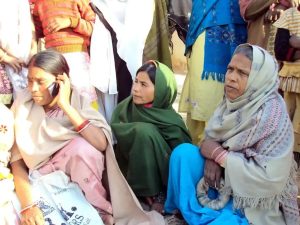Mobile Enabled Services for Rural Women

Image by Gram Vaani
In order to identify ICT based applications that rural women use or can use for livelihood services, we are speaking to experts who have done groundbreaking work in these fields.
We highlight out takeaways from our conversations so far, in this blog post.
Takeaway 1: The need for creating livelihood related ICT solutions with a gendered lens:
There was consensus among the experts we interviewed, about the need to have tailored ICT solutions for rural women seeking livelihood services. First, women play different roles in households, with their contributions often economically invisible. Their ability to work and make work related choices is very different from their male counterparts. Second, they communicate and access information through different channels than men, which can be a function of the kind of social groups they are a part of, lower levels of digital literacy, and access to technology. Lastly, women’s preference for and ability to migrate for work is very different from their male counterparts. Hence, their choice of work is further limited by their mobility.
Takeaway 2: Applications of ICTs for rural women’s livelihoods
The two applications that stood out to us as replicable and scalable ICT solutions that are capable of empowering women and their livelihood choices and outcomes were:
Information Services
Organisations like Digital Green and Gram Vaani create mobile friendly content for information dissemination on topics ranging from maternal and child health, to farming practices, and also fulfilling information needs of persons with disabilities. The Digital Green[1] team told us about their work with the Jharkhand State Livelihood Promotion Society (JSLPS). Digital Green empowers government appointed front line community workers with their video resources on best practices on health and nutrition for dissemination to Self Help Groups and Anganwadi centres.
Gram Vaani’s flagship service Mobile Vaani is an Interactive Voice Response (IVR) service that reaches over 800,000 households across 12 states. Their team[2] walked us through how they have successfully used the IVR platform for grievance redressal and to support women’s labour unions in Tamil Nadu. Both these organisations have reached BPL households, in low literacy regions where internet access may not always be there, and largely serve women.
We found that these tools have the potential to lend themselves very well towards — providing livelihood related information to interested women.
Mobile financial services
Mobile wallets and other digital payments services are making their way into the phones of rural users. However, we are also seeing that ICTs are making it easier for the digitally disconnected to access financial services remotely. Sarbani Banerjee Belur spoke to us about her work with Gram Marg, a rural broadband initiative that brings connectivity and builds a digital ecosystem in rural and remote areas that are left out by network providers. One such village is Pathardi village in Maharashtra, which is characterised by its hilly terrain. The closest mobile tower happens to be in a city 12 kilometers away. As a result, residents of Pathardi can only access mobile network in certain spots of the village. This lack of network combined with the absence of banking facilities in the village made it difficult for Pathardi residents to access banking and e-governance services. Gram Marg empowered Anjali, a Pathardi resident herself, to offer mobile finance services such as cash withdrawal, bill payment services, etc. backed by Aadhar Enabled Payment System. She earns a fixed commission on transaction amount, and villagers using her service can save a day’s travel to the nearest bank, the travel fare, and the loss of wages from missing a day’s work.
In the next phase of our study, we will conduct small scale impact assessments of such ICT interventions to evaluate their impact, profile the rural women they’re reaching, and build a road map for scaling these solutions to be more inclusive.
This research was developed as part of the Bharat Inclusion Research Fellowship.
